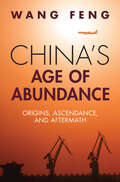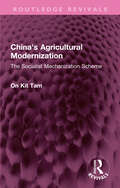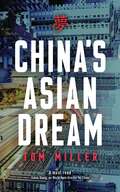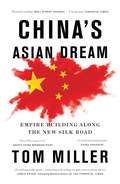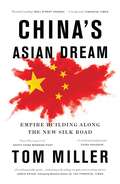- Table View
- List View
China–North Korea Relations: Between Development and Security
This book develops a new approach to exploring China’s relations with North Korea that utilises the concept of developmental peace. Bringing together various strands of Chinese thinking on the mutually reinforcing relationship between economic development, state stability, and international peace and security, the book provides novel insights into Chinese prescriptions for tackling North Korea’s interrelated military and human security challenges. Contributors demonstrate how the lens of developmental peace helps to explain the rationale behind, as well as contradictions and challenges in, China’s relations with North Korea on a range of issues such as denuclearisation, water and energy security, human rights, and economic development. Featuring top scholars from China and South Korea, as well as primary evidence from China, North and South Korea, the book greatly improves the understanding of the current perspectives in each state, and the impact they have on this vital security relationship. Asian studies – and in particular Chinese studies – scholars will appreciate the in-depth analysis of China’s approach to relations with North Korea, as well as the first-hand evidence used. The analysis of the difficulties in China providing a singular approach to its relations will be useful to policy-makers and scholars looking into the complexities of foreign policy.
China’s Achilles’ Heel: The Belt and Road Initiative and Its Indian Discontents
by Srikanth ThaliyakkattilThis book analyses Chinese discourse on Indian attitudes towards the Belt & Road Initiative (BRI), and argues that the Indian discourse is becoming one of the biggest hurdles to China creating its own narrative about China’s rise in Asia and beyond. In doing so, it spans across the themes of the power struggle between China and US, China and India, the Chinese perception of India, China-South Asia relations, the China-US- India strategic triangle and the success and failures of BRI. The first part of the book focuses on the Chinese thinking behind the launch of the BRI and addresses questions related to the purpose of this initiative and ways in which it will facilitate China’s rise as a superpower. Subsequently the book addresses how effective or ineffective India’s challenge is and how it is negatively affecting China’s BRI.
China's African Challenges (Adelphi series)
by Sarah RaineChina’s relations with African nations have changed dramatically over the past decade. African oil now accounts for more than 30% of China’s oil imports, and China is Africa’s second-largest single-country trading partner, as well as a leading lender and infrastructure investor on the continent. Yet these developments are bringing challenges, not only for Africa and the West, but for China as well. This book examines these challenges, considering Africa as a testing ground, both for Chinese companies ‘going global’ and for a Chinese government that is increasingly having to deal with issues beyond its shores and immediate control. What does China need to do to protect and develop its African engagements, against a backdrop of mounting African expectations, concerns from Western actors in Africa, and the rival presence of other emerging actors? How sustainable is the momentum that China has established in its African ventures? China’s adaptations to the challenges it is facing in Africa are examined and assessed, as are the implications of these changes for China, Africa and the West. China’s African engagements are certainly changing Africa, but could they also be changing China?
China's African Challenges (Adelphi series)
by Sarah RaineChina’s relations with African nations have changed dramatically over the past decade. African oil now accounts for more than 30% of China’s oil imports, and China is Africa’s second-largest single-country trading partner, as well as a leading lender and infrastructure investor on the continent. Yet these developments are bringing challenges, not only for Africa and the West, but for China as well. This book examines these challenges, considering Africa as a testing ground, both for Chinese companies ‘going global’ and for a Chinese government that is increasingly having to deal with issues beyond its shores and immediate control. What does China need to do to protect and develop its African engagements, against a backdrop of mounting African expectations, concerns from Western actors in Africa, and the rival presence of other emerging actors? How sustainable is the momentum that China has established in its African ventures? China’s adaptations to the challenges it is facing in Africa are examined and assessed, as are the implications of these changes for China, Africa and the West. China’s African engagements are certainly changing Africa, but could they also be changing China?
China's Age of Abundance: Origins, Ascendance, and Aftermath
by null Feng WangBetween the 1980s and the present day, China has experienced one of the most consequential economic transformations in world history. One-fifth of the Earth's population has left behind a life of scarcity and subsistence for one of abundance and material comfort, while their nation has emerged as a preeminent economic and political power. In a systematic historical and sociological analysis of this unique juncture, Wang Feng charts the origins, forces, and consequences of this meteoric rise in living standards. He shifts the focus away from institutions and policies to offer new perspectives based on consumption among poorer, rural populations as a driver of global economic change. But is this 'Age of Abundance' coming to an end? Anticipating potential headwinds, including an aging population, increasing inequality, and intensifying political control, Wang explores whether this preeminence could be coming to a close.
China's Aging Population: Development and Policy Options (Routledge Studies on the Chinese Economy)
by China Development Research FoundationThis book provides a systematic study of the challenges of aging in China and of the measures being taken, planned, and still needed to cope with the challenges. It highlights that the number of people aged 65 or above is growing and that the growth will accelerate—from 176 million people representing 12.6% of the population in 2019 to 310 million representing 22.3% of the population by 2035, and it also highlights that the aging comes at a time when China’s economy is not yet fully developed and not yet fully balanced. The book outlines how China has already established an elderly care system and is beginning to meet the needs of the elderly for economic security, social services, and so on; discusses the need for enhancing and considerably extending the existing system; and proposes reform ideas and key policy options.
China's Aging Population: Development and Policy Options (Routledge Studies on the Chinese Economy)
by China Development Research FoundationThis book provides a systematic study of the challenges of aging in China and of the measures being taken, planned, and still needed to cope with the challenges. It highlights that the number of people aged 65 or above is growing and that the growth will accelerate—from 176 million people representing 12.6% of the population in 2019 to 310 million representing 22.3% of the population by 2035, and it also highlights that the aging comes at a time when China’s economy is not yet fully developed and not yet fully balanced. The book outlines how China has already established an elderly care system and is beginning to meet the needs of the elderly for economic security, social services, and so on; discusses the need for enhancing and considerably extending the existing system; and proposes reform ideas and key policy options.
China's Agricultural Investment in Australia: Uneven Geographies of Agri-Food Globalization (Routledge Studies in Global Land and Resource Grabbing)
by Michaela BoehmeThis book critically examines the driving forces, discourses, and conflicts surrounding Chinese investments in overseas farmland, with a specific focus on Australia.With growing amounts of finance channeled into the purchase of overseas food and farming assets, China has become a frontrunner in the global land rush. Unlike much of the existing literature that focuses on emerging economies such as Brazil or Africa, this book examines Chinese farmland purchases in the developed country context of Australia. Based on four years of extensive field work in Australia and China, it traces the encounters and interactions between investors, regulators, deal brokers, farmers, and eaters that shape the ways in which individual Chinese investment projects materialize in the Australian countryside. In contrast to conventional wisdom portraying China’s overseas land rush as a state-led strategy to feed the Chinese population, this book reveals that Chinese investments in Australian farmland have been propelled by the intersecting interests of international finance and business elites looking to cash in on booming Chinese demand for high-quality, Western food products. This book provides a unique transnational perspective on China’s overseas farmland purchases and shows how Chinese farmland investments produce uneven geographies of agri-food globalization that cut across national borders. Through the lens of China’s agri-engagement in Australia, this book advances our theoretical understanding of the new types of power relations and dynamics shaping an increasingly multi-polar agri-food system.This book will be useful to students and scholars of agri-food studies, Chinese studies and globalization with an interest in the global land rush and the shifting contours of the global agri-food system.
China's Agricultural Investment in Australia: Uneven Geographies of Agri-Food Globalization (Routledge Studies in Global Land and Resource Grabbing)
by Michaela BoehmeThis book critically examines the driving forces, discourses, and conflicts surrounding Chinese investments in overseas farmland, with a specific focus on Australia.With growing amounts of finance channeled into the purchase of overseas food and farming assets, China has become a frontrunner in the global land rush. Unlike much of the existing literature that focuses on emerging economies such as Brazil or Africa, this book examines Chinese farmland purchases in the developed country context of Australia. Based on four years of extensive field work in Australia and China, it traces the encounters and interactions between investors, regulators, deal brokers, farmers, and eaters that shape the ways in which individual Chinese investment projects materialize in the Australian countryside. In contrast to conventional wisdom portraying China’s overseas land rush as a state-led strategy to feed the Chinese population, this book reveals that Chinese investments in Australian farmland have been propelled by the intersecting interests of international finance and business elites looking to cash in on booming Chinese demand for high-quality, Western food products. This book provides a unique transnational perspective on China’s overseas farmland purchases and shows how Chinese farmland investments produce uneven geographies of agri-food globalization that cut across national borders. Through the lens of China’s agri-engagement in Australia, this book advances our theoretical understanding of the new types of power relations and dynamics shaping an increasingly multi-polar agri-food system.This book will be useful to students and scholars of agri-food studies, Chinese studies and globalization with an interest in the global land rush and the shifting contours of the global agri-food system.
China's Agricultural Modernization: The Socialist Mechanization Scheme (Routledge Revivals)
by On Kit TamOriginally published in 1985, this study investigates the actual experience in mechanization during the Fourth Five Year Plan period, a period which represented, in many ways, a new stage in China’s rural development. It examines the historical perspective and the development approach under which mechanization efforts were exerted during this 5-year period and the mechanism, outcomes and problems these entailed. The book addresses the issues involved in agricultural development and mechanization through a more integral analysis of the way technological transformation has been linked to China’s quest for social and economic development.
China's Agricultural Modernization: The Socialist Mechanization Scheme (Routledge Revivals)
by On Kit TamOriginally published in 1985, this study investigates the actual experience in mechanization during the Fourth Five Year Plan period, a period which represented, in many ways, a new stage in China’s rural development. It examines the historical perspective and the development approach under which mechanization efforts were exerted during this 5-year period and the mechanism, outcomes and problems these entailed. The book addresses the issues involved in agricultural development and mechanization through a more integral analysis of the way technological transformation has been linked to China’s quest for social and economic development.
China's Agriculture at the Cross Roads
by Y. Yang W. TianChina now faces the difficult choice of whether to pursue a food self-sufficiency policy or further integrate its agriculture into the world market. China's choice will have profound implications for the world trading system, as well as for its own economy. At the same time, China needs to reform its land tenure and grain marketing systems. This book examines these majority policy issues using up-to-date information and empirical evidence.
China's Aid to Africa: Does Friendship Really Matter? (Routledge Studies in African Politics and International Relations)
by Zhangxi Cheng Ian TaylorAlthough China has rapidly increased foreign aid to Africa and is now a relatively major player in the developmental assistance regime, little is still known regarding how China delivers its foreign aid, and even less about how this foreign aid actually works in the recipient countries. This book, extensively utilising Chinese sources, much of which have not been available before, examines the effectiveness and sustainability of China's foreign aid in Africa, as well as the political, economic and diplomatic factors that influence Chinese aid disbursement policies. The book argues that a nebulous notion of "friendship", however ill-defined, is a key factor in Chinese aid, something which is often overlooked by Western scholars. Through a detailed examination of both the decision-making process in Chinese aid disbursements, as well as an examination of specific case studies in West Africa, this book improves our understanding of China's foreign aid policies towards Africa. It finds that there are profound shortcomings in China's foreign aid at present which, despite the protestations of "friendship" and solidarity, undermine Beijing’s effectiveness as an actor in the developmental assistance enterprise in Africa. This text will be of key interest to scholars and students of development studies, African studies, China-Africa relations and more broadly to international relations.
China's Aid to Africa: Does Friendship Really Matter? (Routledge Studies in African Politics and International Relations)
by Zhangxi Cheng Ian TaylorAlthough China has rapidly increased foreign aid to Africa and is now a relatively major player in the developmental assistance regime, little is still known regarding how China delivers its foreign aid, and even less about how this foreign aid actually works in the recipient countries. This book, extensively utilising Chinese sources, much of which have not been available before, examines the effectiveness and sustainability of China's foreign aid in Africa, as well as the political, economic and diplomatic factors that influence Chinese aid disbursement policies. The book argues that a nebulous notion of "friendship", however ill-defined, is a key factor in Chinese aid, something which is often overlooked by Western scholars. Through a detailed examination of both the decision-making process in Chinese aid disbursements, as well as an examination of specific case studies in West Africa, this book improves our understanding of China's foreign aid policies towards Africa. It finds that there are profound shortcomings in China's foreign aid at present which, despite the protestations of "friendship" and solidarity, undermine Beijing’s effectiveness as an actor in the developmental assistance enterprise in Africa. This text will be of key interest to scholars and students of development studies, African studies, China-Africa relations and more broadly to international relations.
China’s Aid, Trade and Investment to Africa: Interaction and Coordination (China Perspectives)
by Wang XinyingAdopting perspectives from development economics and international relations, this book researches the ongoing cooperation between China and African countries and the interactive system of China’s aid, trade and investment to and with Africa. In reviewing the history and development of China-Africa relations from the founding of the People’s Republic to the new century, the book analyses the achievements, opportunities and challenges of the bilateral relationship and reflects on the public-private partnership model in the context of international development assistance. Coupled with experiences from the US, Japan and the EU in the field of foreign aid, trade and investment as well as case studies from China, the core chapters delve into China-Africa cooperation in terms of aid, trade and investment and proposes to build an interactive and coordinated mechanism of China’s aid, trade and investment in Africa. The author argues that China-Africa cooperation goes beyond reciprocal benefits, offering a possible model for South-South Cooperation and a potential model for balanced and sustainable development within the world economy. This book will appeal to researchers, students and policy makers interested in Chinese politics and foreign policy, African politics, international relations, international diplomacy and the world economy.
China’s Aid, Trade and Investment to Africa: Interaction and Coordination (China Perspectives)
by Wang XinyingAdopting perspectives from development economics and international relations, this book researches the ongoing cooperation between China and African countries and the interactive system of China’s aid, trade and investment to and with Africa. In reviewing the history and development of China-Africa relations from the founding of the People’s Republic to the new century, the book analyses the achievements, opportunities and challenges of the bilateral relationship and reflects on the public-private partnership model in the context of international development assistance. Coupled with experiences from the US, Japan and the EU in the field of foreign aid, trade and investment as well as case studies from China, the core chapters delve into China-Africa cooperation in terms of aid, trade and investment and proposes to build an interactive and coordinated mechanism of China’s aid, trade and investment in Africa. The author argues that China-Africa cooperation goes beyond reciprocal benefits, offering a possible model for South-South Cooperation and a potential model for balanced and sustainable development within the world economy. This book will appeal to researchers, students and policy makers interested in Chinese politics and foreign policy, African politics, international relations, international diplomacy and the world economy.
China's Air Pollution Problems
by Claudio O. DelangChina’s rapid industrialisation has led to "an air pollution catastrophe". Concerted efforts to achieve economic growth have led to veiled skies of toxic air and created health and morbidity problems as well as tremendous environmental degradation. China’s Air Pollution Problems provides an overview of air pollution in China describing how and why China has ended up in such a dire situation, what the government is doing to address the problem and the difficulties it is encountering in attempting to reduce the pollution. The analysis is based on both grey literature (newspaper articles, NGO reports, Chinese government information) and on academic studies. The grey literature gives a voice to those who suffer from the pollution, their advocates, and government officers, and allows the reader to better grasp the conditions on the ground, and the impact of air pollution among people in different areas in China. The academic literature adds a theoretical perspective and brings these different case studies into a broader context. This book will be of great interest to students of environmental pollution and contemporary Chinese studies looking for an introduction to the topic and also for researchers looking for an extensive list of sources and analysis of China's environmental problems.
China's Air Pollution Problems
by Claudio O. DelangChina’s rapid industrialisation has led to "an air pollution catastrophe". Concerted efforts to achieve economic growth have led to veiled skies of toxic air and created health and morbidity problems as well as tremendous environmental degradation. China’s Air Pollution Problems provides an overview of air pollution in China describing how and why China has ended up in such a dire situation, what the government is doing to address the problem and the difficulties it is encountering in attempting to reduce the pollution. The analysis is based on both grey literature (newspaper articles, NGO reports, Chinese government information) and on academic studies. The grey literature gives a voice to those who suffer from the pollution, their advocates, and government officers, and allows the reader to better grasp the conditions on the ground, and the impact of air pollution among people in different areas in China. The academic literature adds a theoretical perspective and brings these different case studies into a broader context. This book will be of great interest to students of environmental pollution and contemporary Chinese studies looking for an introduction to the topic and also for researchers looking for an extensive list of sources and analysis of China's environmental problems.
China’s Allocation of Fixed Capital Investment, 1952–1957 (Michigan Monographs In Chinese Studies #17)
by Chu-yuan ChengChina’s efforts to stimulate industrial development and economic growth through the allocation of investments are analyzed. Cheng concludes with an overall assessment of the distinctive features of the allocation pattern. Includes 41 statistical tables.
China’s Approach to Energy Security: An International Comparative Perspective
by Shaofeng ChenThis book aims to analyze how and why China takes a state-managed marketization approach (SMMA) to energy security against the backdrop of global efforts of decarbonization and intensified strategic competition between China and the United States. How, and why, does China's SMMA work? Taking an evolving, historical perspective, this book explores China’s perception of energy security, the policy process, institutional restructuring in China's petroleum industry, China's foreign energy quest, and the ramifications of the Chinese approach on the international energy market and on world decarbonization. To demonstrate to what extent China’s SMMA differs from other countries, it also makes a comparative analyses of the approaches by China, the US and India. This book will keenly interest scholars of the Chinese political economy, climate change, and geopolitics.
China's Ascent: Power, Security, and the Future of International Politics (Cornell Studies in Security Affairs)
Assessments of China's importance on the world stage usually focus on a single dimension of China's increasing power, rather than on the multiple sources of China's rise, including its economic might and the continuing modernization of its military. This book offers multiple analytical perspectives—constructivist, liberal, neorealist—on the significance of the many dimensions of China's regional and global influence.Distinguished authors consider the likelihood of conflict and peaceful accommodation as China grows ever stronger. They look at the changing position of China "from the inside": How do Chinese policymakers evaluate the contemporary international order and what are the regional and global implications of that worldview? The authors also address the implications of China's increasing power for Chinese policymaking and for the foreign policies of Korea, Japan, and the United States.
China's Asian Dream: Empire Building along the New Silk Road
by Tom Miller"China", Napoleon once remarked, "is a sleeping lion. Let her sleep, for when she wakes she will shake the world." In 2014, President Xi Jinping triumphantly declared the lion had awakened. Under his leadership, China is pursuing a dream to restore its historical position as the dominant power in Asia.From the Mekong River Basin to the Central Asian steppe, China is flexing its economic muscles for strategic ends. By setting up new regional financial institutions, Beijing is challenging the post-World War II order established under the watchful eye of Washington. And by funding and building roads, railways, ports and power lines-a New Silk Road across Eurasia and through the South China Sea and Indian Ocean-China aims to draw its neighbours ever tighter into its embrace.Combining a geopolitical overview with on-the-ground reportage from a dozen countries, China's Asian Dream offers a fresh perspective on the rise of China' and asks: what does it means for the future of Asia?
China's Asian Dream: Empire Building along the New Silk Road
by Tom Miller'China', Napoleon once remarked, 'is a sleeping lion. Let her sleep, for when she wakes she will shake the world.' In 2014, President Xi Jinping triumphantly declared that the lion had awoken.From holding its ground in trade wars with the US, to presenting itself as a world leader in the fight against climate change, a newly confident China is flexing its economic muscles for strategic ends. With the Belt and Road initiative, billed as a new Silk Road for the 21st Century, China is set to extend its influence throughout Eurasia and across the South China Sea and the Indian Ocean. But with the Chinese and US militaries also vying over the Pacific, does this newfound confidence put China on a collision course with the US?Combining a geopolitical overview with on-the-ground reportage from a dozen countries, this new edition of China's Asian Dream engages with the most recent developments in the ongoing story of China's ascendency, and offers new insights into what the rise of China means not only for Asia, but for the world.
China's Asian Dream: Empire Building along the New Silk Road
by Tom Miller"China", Napoleon once remarked, "is a sleeping lion. Let her sleep, for when she wakes she will shake the world." In 2014, President Xi Jinping triumphantly declared the lion had awakened. Under his leadership, China is pursuing a dream to restore its historical position as the dominant power in Asia.From the Mekong River Basin to the Central Asian steppe, China is flexing its economic muscles for strategic ends. By setting up new regional financial institutions, Beijing is challenging the post-World War II order established under the watchful eye of Washington. And by funding and building roads, railways, ports and power lines-a New Silk Road across Eurasia and through the South China Sea and Indian Ocean-China aims to draw its neighbours ever tighter into its embrace.Combining a geopolitical overview with on-the-ground reportage from a dozen countries, China's Asian Dream offers a fresh perspective on the rise of China' and asks: what does it means for the future of Asia?
China's Asian Dream: Empire Building along the New Silk Road
by Tom Miller'China', Napoleon once remarked, 'is a sleeping lion. Let her sleep, for when she wakes she will shake the world.' In 2014, President Xi Jinping triumphantly declared that the lion had awoken.From holding its ground in trade wars with the US, to presenting itself as a world leader in the fight against climate change, a newly confident China is flexing its economic muscles for strategic ends. With the Belt and Road initiative, billed as a new Silk Road for the 21st Century, China is set to extend its influence throughout Eurasia and across the South China Sea and the Indian Ocean. But with the Chinese and US militaries also vying over the Pacific, does this newfound confidence put China on a collision course with the US?Combining a geopolitical overview with on-the-ground reportage from a dozen countries, this new edition of China's Asian Dream engages with the most recent developments in the ongoing story of China's ascendency, and offers new insights into what the rise of China means not only for Asia, but for the world.




